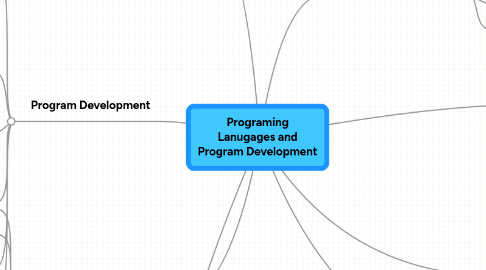
1. Multimedia authoring software
1.1. ToolBook
1.2. Director
2. Procedural Languages
2.1. procedural
2.1.1. Third‐generation language (3GL)
2.2. COBOL
3. Web Page Development
3.1. HTML
3.2. XHTML
3.3. XML
3.3.1. WML
3.3.1.1. RSS 2.0
3.3.1.2. ATOM
3.4. Web page authoring software
3.4.1. Dreamweaver
3.4.2. Expression Web
3.4.3. Flash
3.4.4. SharePoint Designer
4. Program Development
4.1. Step 2
4.1.1. Design Solution
4.1.1.1. Design a solution
4.1.1.1.1. Flowcharting software
4.1.1.2. structured design
4.1.1.3. hierarchy chart
4.1.1.4. object‐oriented
4.2. Step 1
4.2.1. Analyze Requirements
4.2.1.1. Reviews the requirements
4.2.1.2. Meets with the systems analyst and users
4.2.1.3. Identifies input
4.3. Step 3
4.3.1. Validate Design
4.3.1.1. Check for logic errors using test data
4.4. Step 4
4.4.1. Implement Design
4.4.1.1. Generating or providing some or all code
4.4.1.2. Writing the code that translates the design into a computer program
4.4.1.3. Creating the user interface
4.5. Step 5
4.5.1. Test Solution
4.5.1.1. Debugging
4.6. Step 6
4.6.1. Review the program code
4.6.2. Review all the documentation
5. Low‐Level Languages
5.1. Machine
5.2. Only
5.3. Assembly
5.4. source program
6. Tools
6.1. object‐oriented programming (OOP) language
6.1.1. Java
6.1.2. .NET
6.1.3. C++
6.1.4. C#
6.2. PowerBuilder
6.3. 4GL
6.3.1. SQL
6.4. Classic programming languages
6.4.1. Ada
6.4.2. ALGOL
6.4.3. BASIC
6.4.4. FORTRAN
6.4.5. Logo
6.4.6. Pascal
6.4.7. PILOT
6.4.8. Prolog
6.5. application generator
6.5.1. DBMS
6.5.2. macro
6.5.2.1. Record the macro
6.5.2.2. New node
